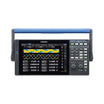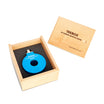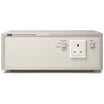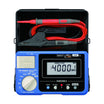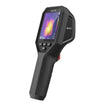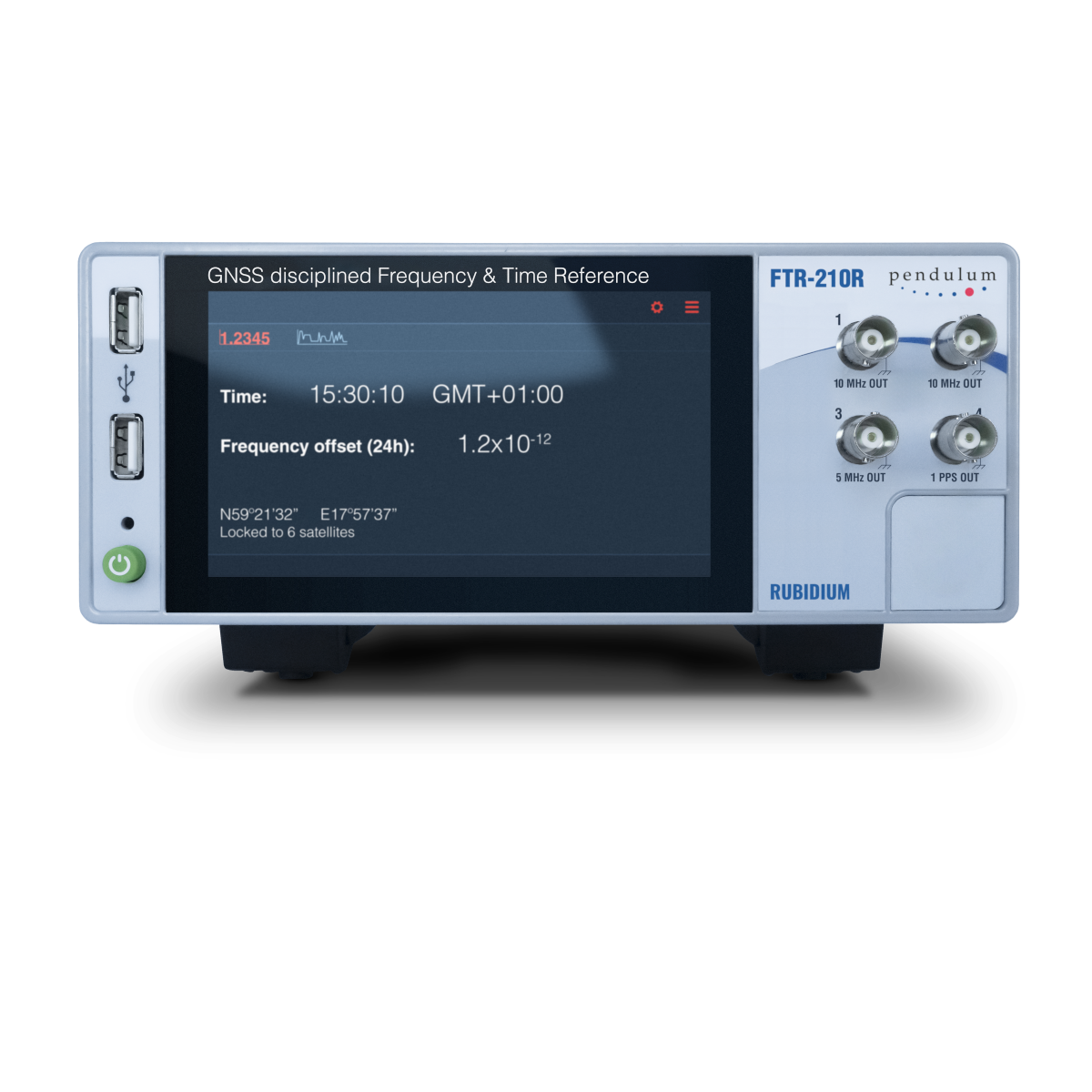
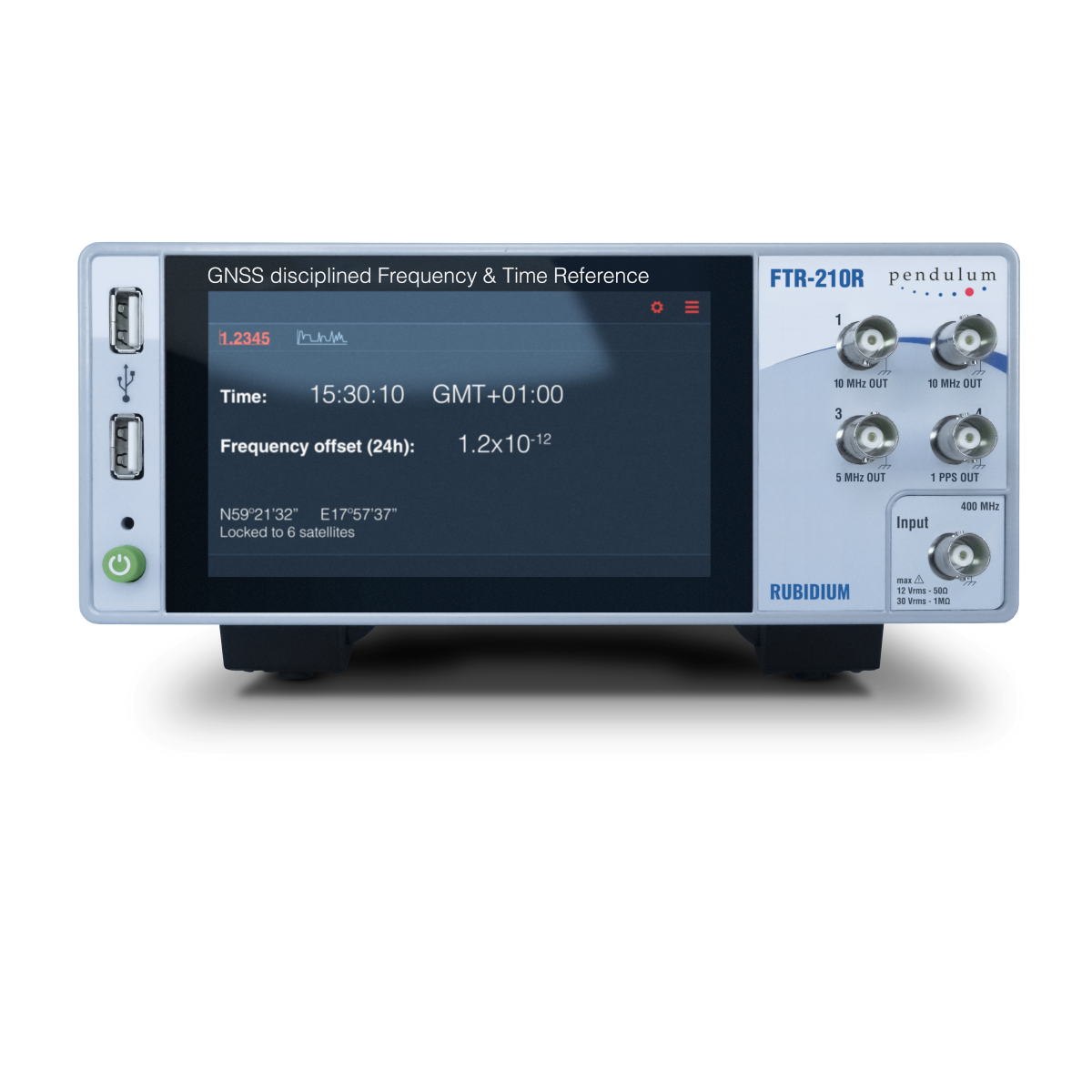
Pendulum FTR-210R GNSS disciplined Frequency & Time Reference
Use our chat for personal support or contact us via +45 31 33 18 19 or salg@GOmeasure.dk
- GNSS disciplined Rubidium atomic clock
- Primary standard traceability option via built-in calibrator and generation of calibration reports
- Optional Frequency measurement input to 400 MHz with ultra-high resolution (up to 12-13 digits/s)
- Up to 9x10 MHz outputs
- 1x5 MHz and 5x10 MHz ultrastable frequency reference outputs as standard
- Optional outputs include: 4x10 MHz, 4x1 pps, or 0.1, 1, 5, 10 MHz
- Optional programmable pulse output 0.5 Hz to 100 MHz
- Web server functionality. Control, monitor, and download data from anywhere in the world via ETH.
- Easy to use
Discover the possibilities
More information
Description
The FTR-210R GNSS disciplined Frequency & Time Reference is a multi-output Frequency Standard, with near Cesium-level stability, thanks to the GNSS control. There are 7 standard outputs (5x10 MHz, 1x5 MHz and 1x1 pps) that can be expanded with up to 4 extra outputs, plus a programmable 100 MHz pulse output option.
The optional integrated indepedent frequency calibrator guarantees true traceability to GPS-time scale and NIST. Traceable calibration reports are easily generated.
An optional input for frequency measurements to 400 MHz turns the FTR-210R into a one-box ultra-high performance frequency calibrator with up to 13 digits resolution in a second.
Frequency and/or Time standard
When used as a GNSS disciplined Frequency standard, the shortterm stability is very high, and ageing is virtually zero.
When used as a stand-alone Frequency standard, in manual hold-over mode, the stability is ultra-high. Ageing is less than 5х10-11/month.
When used as a GNSS disciplined Time standard, the 1 pps time reference output, differs less than 10ns rms from UTC. When GNSS disciplining is removed, the hold-over drift is very low; typical 1 μs/24 h.
Modular, multi-output configuration
The basic configuration contains 5x10 MHz, 1x5 MHz, and 1x1 pps outputs, to support other instruments, testers, or test objects. If that is not sufficient, 4 additional outputs can be fitted on the rear panel. These outputs are either
- 4x10 MHz
- 4x1 pps
- 0.1, 1, 5, and 10 MHz
Additionally you can enable an optional programmable pulse output, 0.5 Hz to 100 MHz, via a SW license, at any time.
Measurement input for one-box frequency calibration
The ultra-stable frequency reference, combined with the optional DC to 400 MHz measurement input, converts the FTR-210R Frequency Reference to a complete one-box frequency calibrator.
Measurement functions include Frequency, Period, Pulse width, Rise/Fall time, Slew Rate, and Voltage (Vmin, Vmax, Vp-p).
TIE (Time Interval Error) is an optional function (SW enabled).
The performance of the measurement input is state-of-the art. You have 14 ps time resolution (7 ps optional) and 12-13 digits of frequency resolution for 1 s gate time. Measurements are gap-free, meaning all individual cycles are counted without any gap.
You can follow short-term and long-term stability of the device under test on the 5” color display, both numerically and graphically. The measurement rate can be set from 1 MSa/s (20 MSa/s optional) up to one sample every 1000 s.
You can store up to 32M measurement samples in each session, and store up to 1G measurements in a non-volatile memory.
The FTR-210R can produce traceable calibration protocols in csv format of both the internal timebase reference (optional), and the device under test, at any time.
Specifications
Documents
Datasheet:
Options
Video
The FTR-210R GNSS disciplined Frequency & Time Reference is a multi-output Frequency Standard, with near Cesium-level stability, thanks to the GNSS control. There are 7 standard outputs (5x10 MHz, 1x5 MHz and 1x1 pps) that can be expanded with up to 4 extra outputs, plus a programmable 100 MHz pulse output option.
The optional integrated indepedent frequency calibrator guarantees true traceability to GPS-time scale and NIST. Traceable calibration reports are easily generated.
An optional input for frequency measurements to 400 MHz turns the FTR-210R into a one-box ultra-high performance frequency calibrator with up to 13 digits resolution in a second.
Frequency and/or Time standard
When used as a GNSS disciplined Frequency standard, the shortterm stability is very high, and ageing is virtually zero.
When used as a stand-alone Frequency standard, in manual hold-over mode, the stability is ultra-high. Ageing is less than 5х10-11/month.
When used as a GNSS disciplined Time standard, the 1 pps time reference output, differs less than 10ns rms from UTC. When GNSS disciplining is removed, the hold-over drift is very low; typical 1 μs/24 h.
Modular, multi-output configuration
The basic configuration contains 5x10 MHz, 1x5 MHz, and 1x1 pps outputs, to support other instruments, testers, or test objects. If that is not sufficient, 4 additional outputs can be fitted on the rear panel. These outputs are either
- 4x10 MHz
- 4x1 pps
- 0.1, 1, 5, and 10 MHz
Additionally you can enable an optional programmable pulse output, 0.5 Hz to 100 MHz, via a SW license, at any time.
Measurement input for one-box frequency calibration
The ultra-stable frequency reference, combined with the optional DC to 400 MHz measurement input, converts the FTR-210R Frequency Reference to a complete one-box frequency calibrator.
Measurement functions include Frequency, Period, Pulse width, Rise/Fall time, Slew Rate, and Voltage (Vmin, Vmax, Vp-p).
TIE (Time Interval Error) is an optional function (SW enabled).
The performance of the measurement input is state-of-the art. You have 14 ps time resolution (7 ps optional) and 12-13 digits of frequency resolution for 1 s gate time. Measurements are gap-free, meaning all individual cycles are counted without any gap.
You can follow short-term and long-term stability of the device under test on the 5” color display, both numerically and graphically. The measurement rate can be set from 1 MSa/s (20 MSa/s optional) up to one sample every 1000 s.
You can store up to 32M measurement samples in each session, and store up to 1G measurements in a non-volatile memory.
The FTR-210R can produce traceable calibration protocols in csv format of both the internal timebase reference (optional), and the device under test, at any time.


